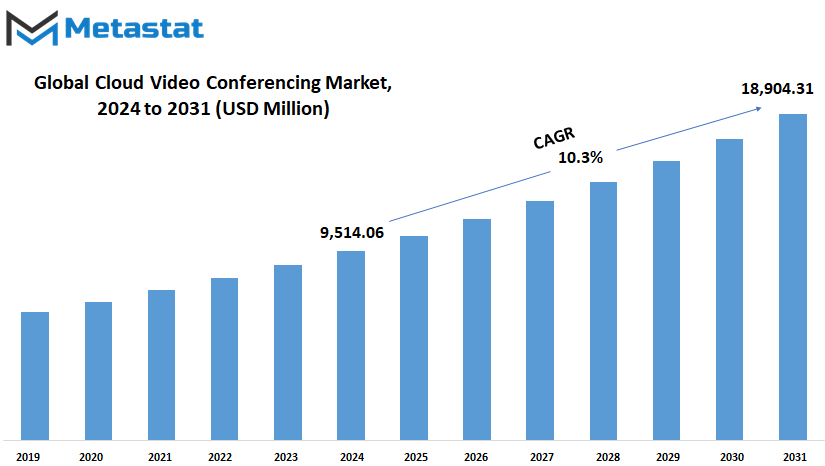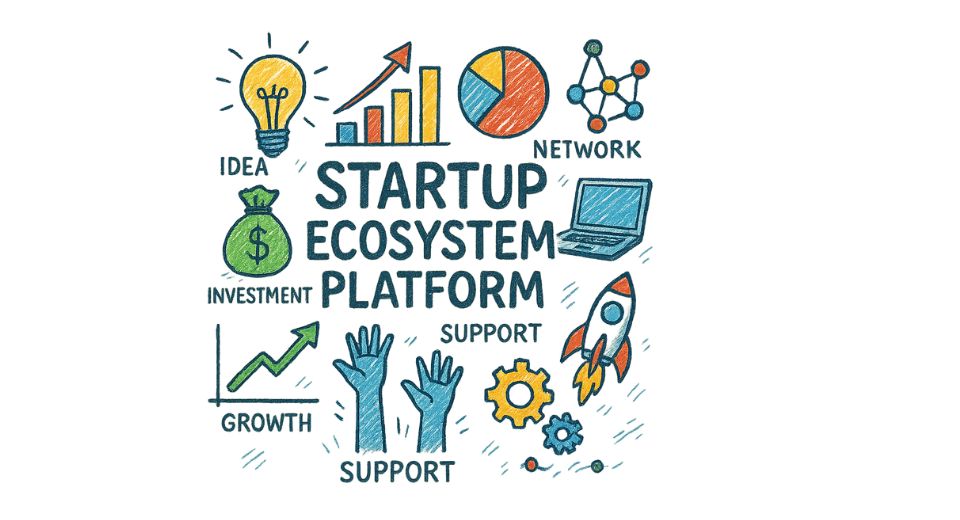MARKET OVERVIEW
The Global Cloud Video Conferencing market is one of the transforming forces in the technology and communication industry, where people can seamlessly interact virtually anywhere in the world. This market deals with the platforms and solutions designed to deliver high-quality video communication in real-time over the internet. Through these technologies, geographical barriers are broken, changing the way individuals, businesses, and organizations connect, collaborate, and share ideas. Global Cloud Video Conferencing serves as the bedrock on which companies aim to efficiently and effectively scale cost-effective communications as part of their growth into a hyperconnected world. In the end, the driving innovation here lies within cloud-based infrastructures providing scalable, reliable video conferencing.
The major difference between traditional on-premises systems and cloud video conferencing solutions is that the latter are hosted on remote servers. This allows users to access and utilize these services without extensive investments in hardware. Therefore, enterprises and individuals enjoy greater flexibility, reduced setup costs, and adaptability to dynamic communication needs. This model supports every kind of small business and large international business by the use of such solutions that comply with the unique needs of such operational requirements. The Global Cloud Video Conferencing market is about much more than communication tools-it is a video collaboration platform service, an all-in-one scheduler tool, an on-demand meeting room, analytics capabilities, etc.
This broad spectrum of offerings ensures that users can engage in meaningful interactions while maintaining productivity and efficiency. Furthermore, cloud video conferencing solutions are increasingly integrated with other digital tools, such as project management software, customer relationship management systems, and artificial intelligence-driven enhancements, creating a seamless and intuitive user experience. Cloud video conferencing technologies have rapidly been adopted by different sectors in education, healthcare, finance, and government. In education, the platforms provide remote learning and virtual classrooms connecting educators and students across different locations. Telemedicine consultations among healthcare professionals allow access to medical expertise in a timely manner.
Financial institutions use cloud-based video conferencing to maintain relationships with clients and conduct virtual team meetings. Worldwide, governments are also using these platforms to discuss policies, negotiate internationally, and bring the public onto the issues. The Global Cloud Video Conferencing market will further evolve with the advancement of cloud computing, artificial intelligence, and augmented reality technologies. Features such as real-time language translation, facial expression analysis, and immersive virtual environments will be added to the service, making the user experience much better.
In addition, the global internet infrastructure will improve, and accessibility will increase, thus bringing the market to new regions and demographics. Security and data privacy will be vital aspects of this market. They must ensure full end-to-end encryption, ensure safe storage, and comply with international regulations, ensuring that end-users trust these service providers.
The demand for hybrid work settings is increasing with time, making the role of cloud video conferencing solutions solid in supporting the flexibility and distance arrangements of a new work structure as an integral part of modern communication tools. The Global Cloud Video Conferencing market stands for a significant aspect of the modern landscape in communication, and this reaches out to acquire more rapidly toward an increasingly diverse set of needs. From technological innovation to constant innovation, this market will be the one driving the future into people’s approach toward global connections and collaboration.
Global Cloud Video Conferencing market is estimated to reach $18,904.31 Million by 2031; growing at a CAGR of 10.3% from 2024 to 2031.

GROWTH FACTORS
The Global Cloud Video Conferencing market is rapidly gaining importance as business and organizations from around the globe adopt digital transformation. As companies demand more applications to work from anywhere and to collaborate virtually, the market of cloud video conferencing is predicted to grow progressively over the years ahead. Across different industries, organizations are placing importance on solutions for effective communication, where geographical locations are of no hindrance to interact effortlessly. This tool, cloud video conferencing, is indispensable today.
One of the main drivers of this market is the general shift towards remote work. With hybrid work models becoming the new norm, businesses need platforms that will not compromise communication and collaboration among teams. Cloud-based video conferencing provides a cost-effective and scalable alternative to traditional systems, doing away with extensive hardware setups and maintenance. This scalability is very appealing to startups and small businesses that need budget-friendly yet robust solutions for their communication needs.
In addition to the cost benefits, the integration of advanced technologies is expected to further propel the market. Features such as AI-powered transcription, automated note-taking, and virtual assistants are transforming the user experience, enhancing productivity during meetings, and minimizing the time spent on manual tasks. These innovations not only improve efficiency but also appeal to organizations looking for cutting-edge solutions to stay competitive in a digital-first world.
However, there are challenges that could hinder the growth of the Global Cloud Video Conferencing market. Data privacy and security remain a concern; this is majorly seen in sectors that deal with sensitive information. Cloud environments are convenient; however, a lot needs to be done regarding measures that could prevent unauthorized access or breaches. There is also dependence on stable internet connections for seamless communication. These platforms will face the problem of being ineffective in regions with low connectivity, thus slowing the rate of adoption in such areas.
Despite all these challenges, the future of this market looks promising. Technology will continue to evolve, and solutions to all these problems are bound to come forth, which will further solidify the market's position. For example, improved encryption technologies will ease security concerns, while better network infrastructures might mitigate connectivity issues.
The Global Cloud Video Conferencing market is likely to gain immensely in the years to come due to the increased demand for remote work tools along with technological advancement. With the incorporation of new features and resolution of existing problems, the market is expected to grow steadily in the future and change the course of global communication.
MARKET SEGMENTATION
By Type
The Global Cloud Video Conferencing market is rising rapidly with a growing demand in businesses and individuals for effective communication solutions. Improving technology brings an increase in the demand for high-quality virtual meetings. This drives innovations across the entire sector. On the basis of type, it can be divided into hardware and software as both have the potential to reshape the way a person and any organization communicate within a digital realm.
Hardware is one of the critical cornerstones of this market, as it's the physical cameras, microphones, and video conferencing equipment. These devices provide strong video and audio to enable an effective virtual communication process. Hardware companies have remained innovative and targeted improving portability, ease-of-use, and platform compatibility. For example, compact high-definition cameras now become a must-have for anyone to see sharp images without the complexity of large mechanical equipment. Hybrid work environments place emphasis on software solutions that must enable easy flow between in-office and remote modes. Here, software, in fact the foundation of video conferencing that works through the clouds, enables to connect and collaboration from anywhere
The platforms popular due to features like instant collaboration, shared screens, and also recording capabilities among others. Developers are investing heavily in artificial intelligence and machine learning to improve user experiences, including automated transcription, background noise suppression, and enhanced security measures. As businesses prioritize data protection, software providers are focusing on encryption and compliance with stringent regulations to address privacy concerns. Looking forward, the Global Cloud Video Conferencing market will expect even further increase. Businesses are increasingly recognizing the cost-effectiveness and scalability of cloud-based solutions compared to traditional on-premises systems, making them a first choice.
Also, technology enhancement with 5G promises faster and stable connections, and therefore, it becomes much more viable to carry out video conferencing even in remote locations. Another exciting development is the integration of cloud video conferencing with other technologies, such as virtual and augmented reality. These developments may change the face of education and healthcare sectors by making virtual classrooms more immersive and remote medical consultations more accessible. In addition, sustainability is likely to impact product development, as manufacturers seek out eco-friendly materials and energy-efficient solutions.
By Deployment Model
The Global Cloud Video Conferencing market will experience immense growth as it fosters a desire for easy solutions to communicate through businesses and personal lives. Recently, this industry has changed how people interact; it makes connections efficient, less expensive, and transcends all physical boundaries. Technology has improved and made video conferencing more available and reliable. It meets the needs of numerous sectors, including educational, health-care, corporate, and government establishments.
One of the most critical factors that determine this market is the flexibility offered by different deployment models. These options include cloud-based and on-premise solutions, each appealing to specific user preferences and organizational requirements. Cloud deployment has gained immense popularity due to its scalability, ease of access, and minimal need for hardware investment. Users only require internet access and compatible devices to engage in high-quality video communication. This model, especially, appeals to startups and small-to-medium-sized businesses because it reduces the overhead of managing physical infrastructure while granting global connectivity. Furthermore, given the constant progress in cloud security and encryption, fears over the safety of the data have dissipated to a great extent and are pushing organizations to opt for this model more frequently.
However, the on-premise model remains an excellent choice for companies who would want total control over their systems and data. It’s mainly an ideal deployment for businesses whose industry requirements need greater security levels in light of compliance and confidential data. It’s costly at the start in terms of hardware investment and subsequent maintenance costs; however, large-scale businesses often opt for it for the personalization that they allow, giving the freedom to not be reliant on third-party vendors.
Ahead of the curve, the Global Cloud Video Conferencing market is to grow further due to the growth of digital transformation globally. Companies will increasingly adopt a hybrid work model, combining the remote and office setup, that will further raise the demand for strong video conferencing solutions. Artificial intelligence and machine learning innovation will also look to enhance the user experience further through real-time language translation, enhanced noise cancellation, and adaptive video quality based on the network conditions.
Such potential for growth reflects the direction the market continues to take: that of further integrating workspaces and services into digital, connected realms. Whether the delivery is by flexibility in the form of cloud-based platforms or bespoke solutions within the on-premise systems, future video conferencing holds excitement around enhanced collaboration and productivity.
By Application
The Global Cloud Video Conferencing market is bound to experience great progress with technological intervention, transforming businesses and interactions into something completely different. Increasingly, it forms a significant opportunity for companies desirous of reducing complexity around communication and operational efficiency in today’s networked world. Indeed, remote working, hybrid models of office practices, and generally digital-first strategy adoption are gaining substantial traction through this form of video conferencing technology, hosted as cloud solutions. These tools eliminate the limitations of a physical place and allow smooth communication between teams, clients, and stakeholders worldwide. The application is divided into corporate communications, training and development, and marketing and client engagement, all contributing to the industry’s future in its own significant way.
Corporate communications are the most prominent of all applications as organizations use such tools to provide smooth, efficient communication among their employees. These aspects, including live video, screen sharing, and real-time messaging, would help companies have better internal communications, reduce time spent on deciding, and deepen workplace relationships. This change in communication patterns translates directly into effectiveness and employee contentment. One of the largest applications that Global Cloud Video Conferencing market can benefit from such innovations is in training and development. Organizations can have virtual training sessions, workshops, and skill development programs without geographical constraints.
Such flexibility not only saves costs but also allows businesses to reach a wider audience, ensuring that employees and partners stay updated on the latest industry trends. Moreover, advancements in interactive features like polls, breakout rooms, and virtual whiteboards make these sessions engaging and effective, promoting better knowledge retention. The role of cloud video conferencing in marketing and client engagement is equally transformative.
Companies are leveraging these tools to connect with clients, conduct product demonstrations, and provide personalized services. This application extends beyond traditional methods, allowing businesses to showcase their offerings to a global audience in a more dynamic and interactive way. The ability to host webinars, live Q&A sessions, and virtual events also strengthens customer relationships and fosters brand loyalty.
The Global Cloud Video Conferencing market will witness more innovative solutions with AI and ML infusion into the service, where real-time transcription and translation would automatically be included. Businesses would go on to implement their digital transformation projects, leading to an increase in demand for the solutions offered above, creating an era of efficient, effective, and accessible communication.
By End-Users
The Global Cloud Video Conferencing market is growing rapidly as technology becomes the bedrock of how businesses and individual communicate. As the world is adopting the fast pace of digitization, video conferencing solutions that are cloud-based are ever increasingly relied upon for frictionless communication. Flexibility and efficiency through such platforms have made it indispensable in numerous diverse industries, including a future where connectivity can surpass all physical boundaries.
Analyzing the industries that use these solutions, it is clear that the Global Cloud Video Conferencing market is driven by the unique needs of different end-users. In the BFSI sector, these tools play a critical role in facilitating secure and real-time communication with clients and between branches. Financial institutions adopt video conferencing to improve on customer service through remote consultations as well as imparting financial literacy. This will ensure that financial businesses are very competitive and attend to the requirements of their customers. Manufacturing companies also adopted cloud-based video conferencing to make their operations more streamlined.
Such solutions enhance productivity because they enable effective collaboration across production sites and with external stakeholders. Engineers, managers, and suppliers can collaborate remotely and ensure that timelines are met without unnecessary delays. The technological shift reduces travel costs and accelerates problem-solving processes in global manufacturing operations. In the Information and Communications Technology industry, demand for advanced communication tools has been quite strong.
Video conferencing helps IT professionals to manage projects and troubleshoot problems without geographic limitations. In the healthcare industry, adoption has been on the rise as well. Doctors and patients can connect securely for consultations, and healthcare providers use video conferencing to train staff and share knowledge.
This application has been of great value, especially during public health emergencies. Education and government sector also contribute well to the rise of the global cloud video conferencing market as schools and institutions have embraced the virtual classroom experience to make study accessible to people all over, while the various government agencies utilized the video-conferencing service through which they deal with the citizenry and work without disruption caused by the onset of crises at any given point in time. The media industry and entertainment find video conferencing useful for an interview, virtual shows, and out-of-office filming.
As technology advances, the Global Cloud Video Conferencing market will continue to advance. Enhanced security measures and immersive features like augmented reality will redefine how people collaborate across sectors, paving the way for a more connected and productive future.
|
Forecast Period |
2024-2031 |
|
Market Size in 2024 |
$9,514.06 million |
|
Market Size by 2031 |
$18,904.31 Million |
|
Growth Rate from 2024 to 2031 |
10.3% |
|
Base Year |
2022 |
|
Regions Covered |
North America, Europe, Asia-Pacific Green, South America, Middle East & Africa |
REGIONAL ANALYSIS
Cloud video conferencing is one of the ways in which globalization is becoming increasingly important in businesses and individuals. With the move of organizations to cloud-based services, the use of video conferencing tools is most likely to surge; hence, an impact is being felt across several regions. From North America to the Middle East and Africa, each region plays a crucial role in the development and expansion of the global market, with different challenges and opportunities shaping their growth.
In North America, the market for Cloud Video Conferencing is poised for rapid growth, with the U.S., Canada, and Mexico leading the way. Demand will continue to be fueled by the region's strong infrastructure, high rates of technological adoption, and major players in the cloud space. North America businesses are increasingly turning to remote work and digital collaboration, making video conferencing solutions essential for operations over time. As such, this region is likely to increase the more advanced cloud-based platforms both in business and personal lives.
Europe is another significant player in the global market, followed by the UK, Germany, France, and Italy. The region focuses on digital transformation in various industries, including education, healthcare, and business, resulting in a high demand for video conferencing tools. Cloud Video Conferencing solutions will be more secure and user-friendly with European nations focusing on enhancing connectivity and ensuring data privacy. This market in Europe will see further growth in collaborative platforms offering seamless integration with other cloud services.
Asia-Pacific will have an increasing demand for Cloud Video Conferencing solutions as the economies are growing rapidly. Many important countries in which the penetration rate for digital technologies continues to soar includes India, China, Japan, and South Korea. In terms of business in these nations, video conferencing tool becomes integral. Alongside rising enterprise-level use of cloud solutions, a new requirement would spring up with ever-growing scalability flexibility in terms of solution delivery. As digital transformation across Asia-Pacific is becoming an ongoing activity, the space is likely to have more domestic and international video conferencing services vying for market share.
Emerging in the digital landscape, South America is a promising growth area for the Cloud Video Conferencing market. The region is slowly getting more connected with Brazil and Argentina being at the forefront. This creates an opportunity for video conferencing solutions to flourish in the region, although the region will face challenges like different levels of technological infrastructure and economic disparities, and the future will be one of steady growth as businesses and educational institutions seek more cost-effective means of communication.
In the Middle East and Africa, adoption of Cloud Video Conferencing will be higher due to the development in technology infrastructure as well as for the better and efficient ways organizations want to collaborate. Growth in the region is expected in the GCC countries, Egypt, and South Africa, where business investment in advanced communication solutions will be more prevalent. The growth of this market in the Middle East and Africa can be achieved only by overcoming the problems like data security concerns and greater connectivity.
Overall, as the global Cloud Video Conferencing market goes to expand, every region will contribute uniquely towards its growth. With the change in work dynamics and growing digital needs, this market's future is all bright and sunny.

COMPETITIVE PLAYERS
The Global Cloud Video Conferencing market is growing rapidly and has a promising future ahead. As companies and individuals transition to digital communications, the importance of cloud video conferencing is becoming more prominent. The industry is expected to grow steadily through technological advancements, increased adoption of remote work, and the high demand for smooth, high-quality communication solutions. As more companies turn to cloud platforms to host their meetings, collaborations, and conferences, the market will probably have an even greater spike in demand.
Among the significant players in the Cloud Video Conferencing market, Zoom Video Communications has come out as a forerunner in the market. Its user interface is simple, but its features are robust and scalable; hence, this has made it popular among not only small businesses but also huge enterprises. Microsoft Teams also comes into play here, especially when it is considered as an all-in-one integration with other Microsoft Office tools, so it is pretty much a no-brainer for any organization already on their platform. Cisco Webex has been the gold standard of the industry for years, boasting secure and reliable services for some of the biggest corporations and government agencies. Another significant competitor to the market is Google Meet. Google Meet has provided an easily accessible user-friendly platform and good integration with Google Workspace. So, the people already working in Google’s environment find this appealing.
The other players are GoToMeeting, which works towards easy usage by business teams, and BlueJeans by Verizon, that is recognized for its video quality in HD and collaboration features. RingCentral Video and Adobe Connect continue to expand their market share through innovative solutions aimed at improving the virtual meeting experience. Zoho Meeting is different because it is integrated with Zoho’s suite of business tools, thus providing a complete communication solution. Other players are also gaining market share by focusing on specialized offerings, such as security, scalability, and custom features tailored to the specific needs of various businesses, in the case of Lifesize, Pexip, Fuze, and LogMeIn.
With firms looking for more improvements in efficiency and convenience and cost-effectiveness, competitive players in the Cloud Video Conferencing market will continue to innovate and bring about enhancements in features such as video quality, security, ease of use, and the integration of artificial intelligence and machine learning for provision of smarter solutions. With the market likely to expand further, organizations will need to take proper care to assess their communication needs and then make the right choices about the platforms they want to use. Competition in the sector will only grow, meaning consumers will have access to a much wider range of options that will cater to their specific needs in the future.
Cloud Video Conferencing Market Key Segments:
By Type
- Hardware
- Software
By Deployment Model
- Cloud
- On-Premise
By Application
- Corporate Communications
- Training and Development
- Marketing and Client Engagement
By End-Users
- Banking, Financial Services, and Insurance (BFSI)
- Manufacturing
- Information and Communications Technology (ICT)
- Healthcare
- Education
- Government
- Media and Entertainment
Key Global Cloud Video Conferencing Industry Players
- Zoom Video Communications
- Microsoft Teams
- Cisco Webex
- Google Meet
- GoToMeeting
- BlueJeans by Verizon
- RingCentral Video
- Adobe Connect
- Zoho Meeting
- Lifesize
- Pexip
- Fuze
- LogMeIn
WHAT REPORT PROVIDES
- Full in-depth analysis of the parent Industry
- Important changes in market and its dynamics
- Segmentation details of the market
- Former, on-going, and projected market analysis in terms of volume and value
- Assessment of niche industry developments
- Market share analysis
- Key strategies of major players
- Emerging segments and regional growth potential








 US: +1 3023308252
US: +1 3023308252






